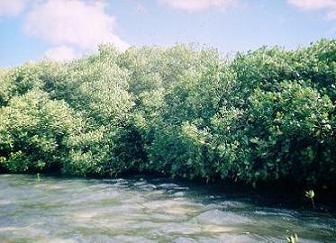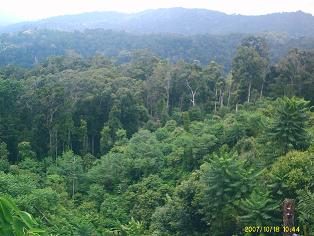| In Sumatra, more than a hundred species of trees are probably commercially exploited. This has resulted in the total forest decreasing from over 23 million ha to less than 16 million ha, with provinces of South Sumatra and Jambi recording the most rapid rates of forest loss (Lampung already had little forest cover in 1985).
North Sumatra has 2.18 million ha of protected areas and 1.63 million ha of production forest, yet the forest cover is only 1.89 million ha. Substantial portions of protected areas are no longer forested. Over the three islands of Sumatra, Kalimantan and Sulawesi, 82% of the conservation forest area has forest cover, but in some provinces the amount is only half of the designated area. Only Aceh in North Sumatra, Central Kalimantan and North Sulawesi still have intact forest cover in their conservation areas. Great swathes of protection forest in North and South Sumatra, Lampung and South Kalimantan are no longer tree covered. Over all of Indonesia, only 60% of the protection forest still has forest cover. In Lampung, this is only 6% and in South Sumatra it is 25%.
|

|
In Sumatra, the dry lowland plains will lose essentially all their dominant forest cover soon after 2005. Land clearing will continue in the swamp forests and is likely to increase in the hill and mountain forests as the area of the other types diminishes. Thus in Sumatra, in a decade or so, most of the remaining intact forests will be in the hills and mountains. Between the mid 1980s and 1993, Sumatran mangroves decreased by 29% (681,700 ha to 485,025 ha) (World Bank 2001).
Regeneration in Sumatra after selective logging suggests that it is unlikely that regenerated forests will grow to their original heights (Ng 1983). Forestry practices directly and indirectly affect animal distributions and numbers. Some animals will be found in the most disturbed areas. Proper selective logging is considered not disastrous for much of the Sumatran forests, although squirrels and birds can be expected to fare badly (Whitten et al. 1997).
The extensive forest fires of 1997 and 1998 in Sumatra damaged 1,740,000 ha. The majority of forest that was burnt was 380,000 ha of lowland forest, 300,000 ha of swamp forest and 260,000 ha of scrub and grass, with the remainder timber plantations, agricultural lands and estate crops.
Protected Area Coverage
Sumatra has nine national parks; these are at the core of the protected areas system of Sumatra. Two of these National Parks are huge. These are Gunung Leuser in South Aceh and North Sumatra, and Kerinci Seblat in West Sumatra, both of which are approximately 1,000,000 ha. Gunung Leuser is also a Biosphere Reserve established because of its unique assemblages of fauna, including hornbills, Golden Cat (Catopuma temminckii), and its habitats that range from Lowland Rainforest, Peat Swamp Forest, Freshwater Swamp Forest and lakes to Sub-alpine Forests. The World Bank (2001) report did not recommend any specific additions to the protected area system in Sumatra, indicating that they considered it, by comparison to other islands in Indonesia, to be representative.
Sumatra has had two important recent additions to its protected areas: Bukit Tigapuluh National Park, Riau Province, and important additions to Gunung Leuser (such as Singkil). However, both of these two National Parks have become increasingly threatened from local communities. For example, there are at least 25 sawmills operating in the neighborhood of Bukit Tigapuluh National Park. Gunung Leuser is also under great threat from illegal logging (World Bank 2001).
In fact, most national parks in Sumatra are currently suffering multiple threats from human activity. Some 30,000 ha of forests in the northern areas of Bukit Barisan Selatan National Park have been lost in the last few years, and there are major problems with illegal logging in both Gunung Leuser and Bukit Tigapuluh National Parks (World Bank 2001).
The management of Gunung Leuser National Park has been assigned to a NGO, the Lueser International Foundation, which also has responsibility for managing protection and productive forest lands on the border of North Sumatra an Aceh. Most funds to this Foundation are from the European Union. Despite this innovative management approach, the National Park has suffered high levels of damage, and the increase in illegal logging inside the Park was stated to be “dramatic” by the World Bank (2001). The World Bank (2001) further states “the army, police, national park staff and other members of the local elites are usually involved.” The World Bank (2001) considers that the habitat of the Orangutan in the Park will be destroyed by about 2006, and that its herds of elephant have been so fragmented that they are now below the threshold for their long-term survival.
Kerinci Seblat National Park, even after an ambitious integrated conservation and development project involving some $47 million, has not been able to show success in conserving its biota. In fact, the Park has fallen under increased threats.
|
These threats involve the building of roads that increase access into the Park, conversion of land for agricultural purposes, removal of timber and non-timber forest products and hunting.
Many forest people in Sumatra, such as the forest edge people on Siberut Island and the Kubu on the mainland, are now hunting with access to new markets and new technologies; their hunting is becoming increasingly less sustainable. Numerous nontimber forest products are also extracted from protected areas in Sumatra.
Next >>> |
Source : Report on Biodiversity and Tropical Forests in Indonesia, USAID/Indonesia, 2004. Prepared by : (1) Steve Rhee, M.E.Sc. (2) Darrell Kitchener, Ph.D. (3) Tim Brown, Ph.D. (4) Reed Merrill, M.Sc. (5) Russ Dilts, Ph.D. (6) Stacey Tighe, Ph.D. |
|




